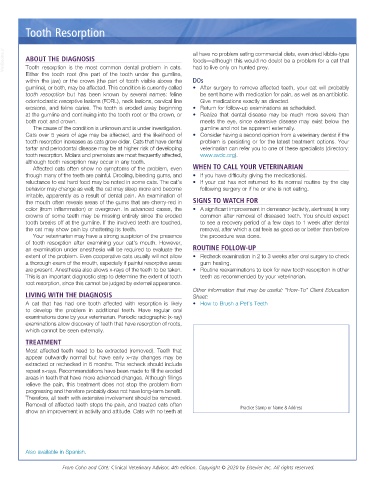Page 3136 - Cote clinical veterinary advisor dogs and cats 4th
P. 3136
Tooth Resorption
VetBooks.ir ABOUT THE DIAGNOSIS all have no problem eating commercial diets, even dried kibble-type
foods—although this would no doubt be a problem for a cat that
had to live only on hunted prey.
Tooth resorption is the most common dental problem in cats.
Either the tooth root (the part of the tooth under the gumline,
within the jaw) or the crown (the part of tooth visible above the DOs
gumline), or both, may be affected. This condition is currently called • After surgery to remove affected teeth, your cat will probably
tooth resorption but has been known by several names: feline be sent home with medication for pain, as well as an antibiotic.
odontoclastic resorptive lesions (FORL), neck lesions, cervical line Give medications exactly as directed.
erosions, and feline caries. The tooth is eroded away beginning • Return for follow-up examinations as scheduled.
at the gumline and continuing into the tooth root or the crown, or • Realize that dental disease may be much more severe than
both root and crown. meets the eye, since extensive disease may exist below the
The cause of the condition is unknown and is under investigation. gumline and not be apparent externally.
Cats over 5 years of age may be affected, and the likelihood of • Consider having a second opinion from a veterinary dentist if the
tooth resorption increases as cats grow older. Cats that have dental problem is persisting or for the latest treatment options. Your
tartar and periodontal disease may be at higher risk of developing veterinarian can refer you to one of these specialists (directory:
tooth resorption. Molars and premolars are most frequently affected, www.avdc.org).
although tooth resorption may occur in any tooth.
Affected cats often show no symptoms of the problem, even WHEN TO CALL YOUR VETERINARIAN
though many of the teeth are painful. Drooling, bleeding gums, and • If you have difficulty giving the medication(s).
reluctance to eat hard food may be noted in some cats. The cat’s • If your cat has not returned to its normal routine by the day
behavior may change as well; the cat may sleep more and become following surgery or if he or she is not eating.
irritable, apparently as a result of dental pain. An examination of
the mouth often reveals areas of the gums that are cherry-red in SIGNS TO WATCH FOR
color (from inflammation) or overgrown. In advanced cases, the • A significant improvement in demeanor (activity, alertness) is very
crowns of some teeth may be missing entirely since the eroded common after removal of diseased teeth. You should expect
tooth breaks off at the gumline. If the involved teeth are touched, to see a recovery period of a few days to 1 week after dental
the cat may show pain by chattering its teeth. removal, after which a cat feels as good as or better than before
Your veterinarian may have a strong suspicion of the presence the procedure was done.
of tooth resorption after examining your cat’s mouth. However,
an examination under anesthesia will be required to evaluate the ROUTINE FOLLOW-UP
extent of the problem. Even cooperative cats usually will not allow • Recheck examination in 2 to 3 weeks after oral surgery to check
a thorough exam of the mouth, especially if painful resorptive areas gum healing.
are present. Anesthesia also allows x-rays of the teeth to be taken. • Routine reexaminations to look for new tooth resorption in other
This is an important diagnostic step to determine the extent of tooth teeth as recommended by your veterinarian.
root resorption, since this cannot be judged by external appearance.
Other information that may be useful: “How-To” Client Education
LIVING WITH THE DIAGNOSIS Sheet:
A cat that has had one tooth affected with resorption is likely • How to Brush a Pet’s Teeth
to develop the problem in additional teeth. Have regular oral
examinations done by your veterinarian. Periodic radiographic (x-ray)
examinations allow discovery of teeth that have resorption of roots,
which cannot be seen externally.
TREATMENT
Most affected teeth need to be extracted (removed). Teeth that
appear outwardly normal but have early x-ray changes may be
extracted or rechecked in 6 months. This recheck should include
repeat x-rays. Recommendations have been made to fill the eroded
areas in teeth that have more advanced changes. Although fillings
relieve the pain, this treatment does not stop the problem from
progressing and therefore probably does not have long-term benefit.
Therefore, all teeth with extensive involvement should be removed.
Removal of affected teeth stops the pain, and treated cats often
show an improvement in activity and attitude. Cats with no teeth at Practice Stamp or Name & Address
Also available in Spanish.
From Cohn and Côté: Clinical Veterinary Advisor, 4th edition. Copyright © 2020 by Elsevier Inc. All rights reserved.

